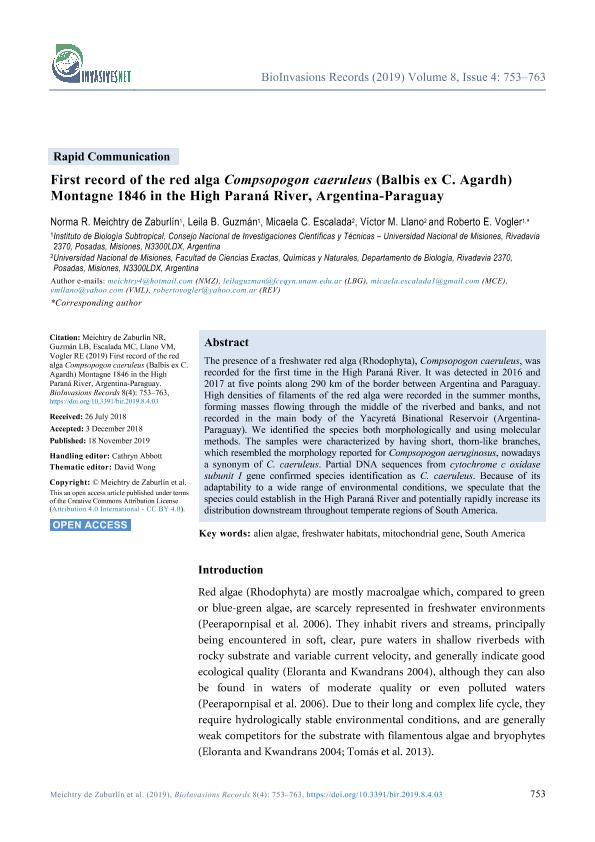Artículo
First record of the red alga Compsopogon caeruleus (Balbis ex C. Agardh) Montagne 1846 in the High Paraná River, Argentina-Paraguay
Meichtry Zaburlin, Norma Rosa; Guzmán, Leila Belén ; Escalada, Micaela Carolina; Llano, Víctor Martín; Vogler, Roberto Eugenio
; Escalada, Micaela Carolina; Llano, Víctor Martín; Vogler, Roberto Eugenio
 ; Escalada, Micaela Carolina; Llano, Víctor Martín; Vogler, Roberto Eugenio
; Escalada, Micaela Carolina; Llano, Víctor Martín; Vogler, Roberto Eugenio
Fecha de publicación:
11/2019
Editorial:
Regional Euro-Asian Biological Invasions Centre
Revista:
BioInvasions Records
ISSN:
2242-1300
Idioma:
Inglés
Tipo de recurso:
Artículo publicado
Clasificación temática:
Resumen
The presence of a freshwater red alga (Rhodophyta), Compsopogon caeruleus, was recorded for the first time in the High Paraná River. It was detected in 2016 and 2017 at five points along 290 km of the border between Argentina and Paraguay. High densities of filaments of the red alga were recorded in the summer months, forming masses flowing through the middle of the riverbed and banks, and not recorded in the main body of the Yacyretá Binational Reservoir (Argentina-Paraguay). We identified the species both morphologically and using molecular methods. The samples were characterized by having short, thorn-like branches, which resembled the morphology reported for Compsopogon aeruginosus, nowadays a synonym of C. caeruleus. Partial DNA sequences from cytochrome c oxidase subunit I gene confirmed species identification as C. caeruleus. Because of its adaptability to a wide range of environmental conditions, we speculate that the species could establish in the High Paraná River and potentially rapidly increase its distribution downstream throughout temperate regions of South America.
Palabras clave:
ALIEN ALGAE
,
FRESHWATER HABITATS
,
MITOCHONDRIAL GENE
,
SOUTH AMERICA
Archivos asociados
Licencia
Identificadores
Colecciones
Articulos(IBS)
Articulos de INSTITUTO DE BIOLOGIA SUBTROPICAL
Articulos de INSTITUTO DE BIOLOGIA SUBTROPICAL
Citación
Meichtry Zaburlin, Norma Rosa; Guzmán, Leila Belén; Escalada, Micaela Carolina; Llano, Víctor Martín; Vogler, Roberto Eugenio; First record of the red alga Compsopogon caeruleus (Balbis ex C. Agardh) Montagne 1846 in the High Paraná River, Argentina-Paraguay; Regional Euro-Asian Biological Invasions Centre; BioInvasions Records; 8; 4; 11-2019; 753-763
Compartir
Altmétricas



